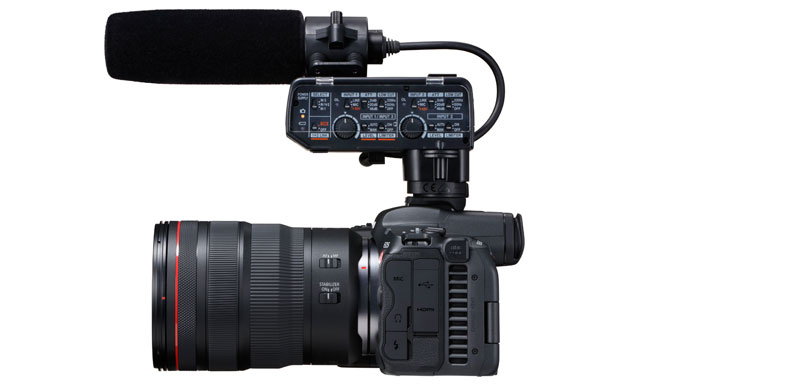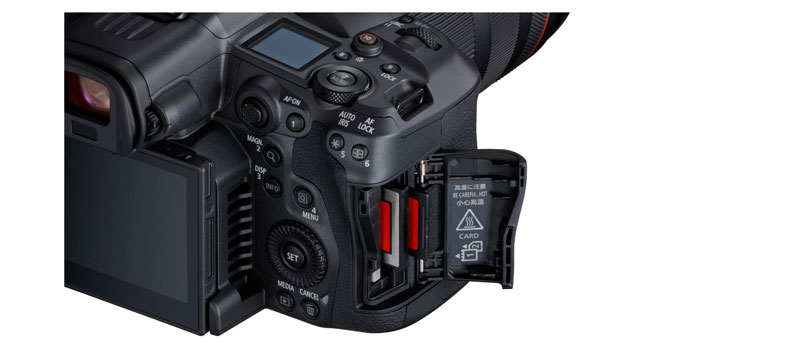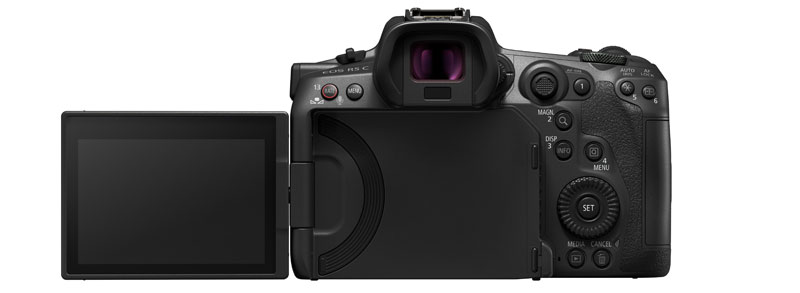The new Canon EOS R5 C has a full frame CMOS sensor, DIGIC X processor and an RF lens mount, capable of 8K video and 45 megapixel stills capture at burst speeds up to 20 fps.

The new Canon Cinema EOS R5 C has a high-resolution, full frame CMOS sensor, DIGIC X processor and an RF lens mount, capable of 8K video capture and 45 megapixel still photo capture at burst speeds of up to 20 fps.
The EOS R5 C can record 8K 30p RAW video internally, achieving a high level of clarity and flexibility in post. An internal active cooling system allows shooting at 8K for extended periods depending on memory card capacity and battery. Capturing 8K RAW at up to 60p is also possible by connecting to an external power source through specialised couplers and adaptors that are sold separately.
Shooting with the EOS R5 C’s full frame 8K sensor, a user can record 4K and full-HD with greater clarity, more accurate colour and lower noise than with a regular sensor, through internal oversampling. Being able to do this also means of High Frame Rate content can be recorded at 4K 120p resolution, without cropping the angle of view and maintaining auto focus functionality.

The 45-megapixel sensor and DIGIC X processor produce very high quality stills at burst rates of up to 20 fps. The DIGIC X processor supports noise processing resulting in sensitivity as high as 51,200 ISO for shooting in low-light environments such as indoor sports.
Auto Focus and HDR
The camera is built with Canon’s Dual Pixel CMOS AF system that includes Eye AF, enabling it to identify an eye in the scene and track and focus on it. It also includes EOS iTR AF X, a type of autofocus for moving subjects that recognises, identifies and follows subjects around the frame. Working in combination with the Optical IS in compatible lenses, the camera also has electronic image stabilisation with coordinated control that mitigates the effects of shaking when shooting hand-held.
HDR video is supported via PQ and HLG, as well as Canon Log 3 gamma. 10-bit HEIF (High Efficiency Image File Format) images can be captured with extended dynamic range and colour gamut. This format collects images in a single container file, for example to store burst photos, or to simultaneously capture video and still images, such as stills and timed image sequences into the same file. Other options are available with the interval timer, supporting very high resolution time-lapse content.

8K Workflows
The EOS R5 C records Cinema RAW Light internally – high fidelity 12-bit footage with a wide dynamic range and colour gamut in a manageable file size. Canon has also developed three new RAW variations – RAW HQ (High Quality), RAW ST (Standard Quality) and RAW LT (Light Quality).
Two different card slots – a CFexpress 2.0 Type B and a UHS-II SD card slot – support simultaneous recording options where different formats, resolutions and bit depths can be recorded to each card at the same time. This includes audio recording when shooting at 4K 120p. As well as 12-bit Cinema RAW Light, the EOS R5 C supports the Canon 10-bit XF-AVC format up to 810Mbps, and MP4 options.
For ease of use, the EOS R5 C has two separate menus for stills and video – the EOS R system and Cinema EOS interface. Controlled by a 3-position power dial, users can switch directly between modes and access the relevant settings. With 13 assignable buttons and professional video features, the EOS R5 C allows customisation as well.

Lenses and Accessories
The camera’s RF mount, compatible with Canon’s EF, RF and cinema lens line-up, has a short flange focal distance and a 12-pin connection for fast communication between the camera body and lens. The camera’s ability to combine 8K video with the new Canon RF 5.2mm F2.8L Dual Fisheye lens supports VR footage production and post.
It has the same Multi-Function Accessory Shoe as the EOS R3 and XF605 for directly connecting and powering accessories such as Canon’s DM-E1D Stereo Microphone and TASCAM’s CA-XLR2d Audio XLR Adapter. The EOS R5 C has also been fitted with a dedicated Timecode In/Out terminal for integrating into a professional multi-camera set-up. Its connectivity means the Apple Content Transfer Mobile application, available on iPhones, can be used for FTP transfers and the editing of ML-G2 metadata, which also suits news gathering and solo shooters.
The EOS R5 C has a 0.5-inch high-resolution OLED viewfinder with 5.76 million dots for accurate image analysis, and a dotmatrix display on the top for checking camera settings. The 3.2-inch HD LCD monitor articulates for viewing from multiple angles and is bright enough to use in full daylight or at night.

Designed mainly for solo shooters, the EOS R5 C chassis is made of magnesium alloy and weighs only 680g, making it the smallest, lightest Cinema EOS camera so far. Its dust and weather sealing design separates airflow from the electrical components.
The Canon EOS R5 C will be available in Australia in March 2022 with an RRP of $7,499, and will be supported by Canon’s 5-year warranty when purchased from an authorised reseller.
EOS C70 Firmware Update
A further announcement from Canon advises that the latest C70 firmware update also adds a Cinema RAW Light LT 4K recording option with XF-AVC proxy recording function to support it, and new Frame and Interval recording options, such as stop frame animation and time lapse video. The firmware released in December 2021 extends compatibility to 12 further lenses when using the EF-EOS R 0.71x Mount Adaptor, with full optical correction, metadata and auto focus support.
The new EOS C70 firmware will be available to download from late March 2022. www.canon.com




